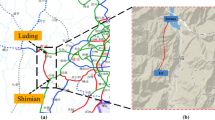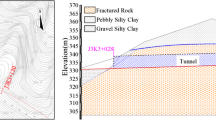Abstract
The tunnel in jointed rock masses is prone to be overbroken and then gives rise to collapse, yet the failure modes of jointed rock masses are still poorly understood. This paper investigates anisotropic deformations and failure modes of tunnels in jointed rock masses. For this purpose, five series of numerical models are modeled for a severe tunnel overbreak occurring on the Panlongshan tunnel. The ubiquitous joint model is used to consider the shearing and tensioning effects of the bedding and joint structures. The factors affecting anisotropic deformation and failure of rock masses, such as bedding spacing (s), joint dip angles (θ), and joint spacing (d), are discussed. The results demonstrate that for the stratified rock masses (without joint), the maximum settlement around the tunnel is located at the roof, and the separation of “virtual blocks” along the bedding planes is a basic failure mode; for stratified rock masses containing joints, the maximum deformation surrounding the tunnel appears in the joint position, and failure happens through a combined rotation, sliding, and falling mechanism. Our study can also reveal that with the increase of the number of joints, the plastic zone at the joint positions has a developing tendency towards the deep part. The more complex the joint structures in jointed rock masses are, the more unstable rock masses are formed.












Similar content being viewed by others
References
Wu B (2016) Study on disturbance zone evolution and anchoring mechanism of surrounding rock in layered rock tunnel. China University of Geosciences, Wuhan, China, Doctoral dissertation (in Chinese)
Lisjak A, Grasselli G, Vietor T (2014) Continuum–discontinuum analysis of failure mechanisms around unsupported circular excavations in anisotropic clay shales. International Journal of Rock Mechanics and Mining Sciences. 65(19):96–115
Zhang Y, Liu Y (2002) Three-dimensional elastic-plastic finite element analysis of stratified rock. Chinese Journal of Rock Mechanics and Engineering. 21(11):1615–1619 (in Chinese)
Goodman RE (1989) Introduction to rock mechanics, second ed. John Wiley and Sons, New York, 1989.
Wu JH, Ohnishi Y, Nishiyama S (2004) Simulation of the mechanical behavior of inclined jointed rock masses during tunnel construction using discontinuous deformation analysis (DDA). International Journal of Rock Mechanics and Mining Sciences. 41(5):731–743
Huang X, Zhang Z (2012) Stress arch bunch and its formation mechanism in blocky stratified rock masses. Journal of Rock Mechanics and Geotechnical Engineering. 4(1):19–27
Stille H, Palmstrom A (2008) Ground behaviour and rock mass composition in underground excavations. Tunnelling Underground Space Technology. 23(1):46–64
Zheng Y, Wang Y, Wang C et al (2011) Stability analysis and exploration of failure law of jointed rock tunnel——seminor on tunnel stability analysis. Chinese Journal of Underground Space and Engineering. 7(4):649–656 (in Chinese)
Wang P, Cai M, Ren F (2018) Anisotropy and directionality of tensile behaviours of a jointed rock mass subjected to numerical Brazilian tests. Tunnelling and Underground Space Technology. 73:139–153
Evans WH (1941) The strength of undermined strata. Trans. Inst. Min. Metall. 50:475–500
Beer G, Meek JL (1982) Design curves for roofs and hanging-walls in bedded rock based on ‘voussoir’ beam and plate solutions. Trans. Inst. Min. Metall. 91:A18–A22
Xiao Y, Ding E (1993) Study on the stability of the jointed roof. Chinese Journal of Rock Mechanics and Engineering. 12(4):353–365 (in Chinese)
Diederichs MS, Kaiser PK (1999) Stability of large excavations in laminated hard rock masses: the voussoir analogue revisited. International Journal of Rock Mechanics and Mining Sciences. 36(1):97–117
Yang J, Yang W, Guo Y (2001) Analysis of buckling failure of layered roof of coal roadway. Journal of China Coal Society. 26(3):240–244 (in Chinese)
Huang N, Liu R, Jiang Y, Cheng Y, Li B (2019) Shear-flow coupling characteristics of a three-dimensional discrete fracture network-fault model considering stress-induced aperture variations. Journal of Hydrology 571:416–424
Hao YH, Azzam R (2005) The plastic zones and displacements around underground openings in rock masses containing a fault. Tunnelling and Underground Space Technology incorporating Trenchless Technology Research. 20(1):49–61
Jiang Y, Tanabashi Y, Li B, Xiao J (2006) Influence of geometrical distribution of rock joints on deformational behavior of underground opening. Tunnelling and Underground Space Technology. 21(5):485–491
Jia P, Tang CA (2008) Numerical study on failure mechanism of tunnel in jointed rock mass. Tunnelling & Underground Space Technology Incorporating Trenchless Technology Research 223(5):500–507
Jeon S, Kim J, Seo Y, Hong C (2004) Effect of a fault and weak plane on the stability of a tunnel in rock – a scaled model test and numerical analysis. International Journal of Rock Mechanics and Mining Science. 41(1):658–663
Liu X, Chen H, He C (2017) Model test and stress distribution law of unsymmetrical loading tunnel in bedding rock mass. Arabian Journal of Geosciences. 10(7):184
Chen X, Liao Z, Peng X (2013) Cracking process of rock mass models under uniaxial compression. J. Cent. South Univ. 20:1661–1678
Bahaaddini M, Sharrock G, Hebblewhite B (2013) Numerical investigation of the effect of joint geometrical parameters on the mechanical properties of a non-persistent jointed rock mass under uniaxial compression. Comput. Geotech. 49:206–225
Han G, Jing H, Jiang Y, Liu R, Su H, Wu J (2018) The effect of joint dip angle on the mechanical behavior of infilled jointed rock masses under uniaxial and biaxial compressions. Processes. 6:49
Jaeger JC, Cook N (1979) Fundamentals of rock mechanics. third edition. Science Paperbacks. 9(3):251–252(2)
Prudencio M, Jan MVS (2007) Strength and failure modes of rock mass models with non-persistent joints. International Journal of Rock Mechanics and Mining Sciences. 44(6):890–902
Zhang ZX, Xu Y, Kulatilake PHSW, Huang X (2012) Physical model test and numerical analysis on the behavior of stratified rock masses during underground excavation. International Journal of Rock Mechanics and Mining Sciences. 49:134–147
Song JJ, Lee CI, Seto M (2001) Stability analysis of rock blocks around a tunnel using a statistical joint modeling technique [J]. Tunnelling and Underground Space Technology. 16(4):341–351
Itasca Consulting Group, Inc. (2012) FLAC3D (Fast Lagrangian Analysis of Continua in Three-dimensions), version 5.0, user’s manual. Itasca Consulting Group, Inc.
Yang ZM, Wu SC, Gao YT, Jin AB, Cong ZJ (2018) Time and technique of rehabilitation for large deformation of tunnels in jointed rock masses based on FDM and DEM numerical modeling. Tunnelling and Underground Space Technology. 81:669–681
Wang TT, Huang TH (2009) A constitutive model for the deformation of a rock mass containing sets of ubiquitous joints. International Journal of Rock Mechanics and Mining Sciences. 46(3):521–530
Sainsbury BL, Sainsbury DP (2017) Practical use of the ubiquitous-joint constitutive model for the simulation of anisotropic rock masses. Rock Mechanics and Rock Engineering. 50:1–22
Das AJ, Mandal PK, Bhattacharjee R, Tiwari S, Kushwaha A, Roy LB (2017) Evaluation of stability of underground workings for exploitation of an inclined coal seam by the ubiquitous joint model. International Journal of Rock Mechanics and Mining Sciences. 93:101–114
Goodman RE (1976) Methods of geological engineering in discontinuous rocks. West Pub, Co
Mei S (2008) Study on deformation mechanism and failure characteristics of layered rock masses due to excavation. Doctoral dissertation. Wuhan Institute of Rock and Soil Mechanics. The Chinese Academy of Science, P. R. China. (in Chinese).
Funding
This research was supported by the National Nature Science Foundation of People’s Republic of China (Grant No. 50909056).
Author information
Authors and Affiliations
Contributions
B.X. (Bangshu Xu), W.Z. (Wanzhi Zhang), G.Y. (Guangyao Yue), and W.S (Weihang Shi) carried out the field monitoring and obtained the overbreak data; W.Z. and J.M. (Jie Mei) performed the numerical experiments and wrote the original manuscript; B.X. reviewed and revised the original manuscript.
Corresponding author
Ethics declarations
Conflict of interest
The authors declare that they have no conflict of interest.
Additional information
Responsible Editor: Marco Barla
Rights and permissions
About this article
Cite this article
Zhang, W., Xu, B., Mei, J. et al. A numerical study on mechanical behavior of jointed rock masses after tunnel excavation. Arab J Geosci 13, 416 (2020). https://doi.org/10.1007/s12517-020-05358-y
Received:
Accepted:
Published:
DOI: https://doi.org/10.1007/s12517-020-05358-y




